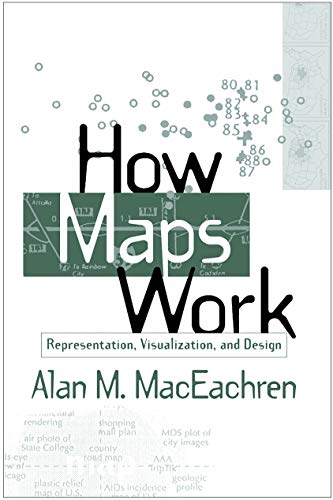
Sinopsis
This book is the first systematic integration of cognitive and semiotic approaches to understanding maps as powerful, abstract, and synthetic spatial representations. Presenting a perspective built on four decades of cartographic research, it explores how maps work at multiple levels--from the cognitive to the societal--and provides a cohesive picture of how the many representational choices inherent in mapping interact with the processing of information and construction of knowledge. «MDUL»«MDNM»Utilizing this complex perspective, the author shows how the insights derived from a better understanding of maps can be used in future map design. Although computers now provide the graphic tools to produce maps of similar or better quality than previous manual techniques, they seldom incorporate the conceptual tools needed to make informed symbolization and design decisions. The search for these conceptual tools is the basis for «MDUL»How Maps Work«MDNM».
"Sinopsis" puede pertenecer a otra edición de este libro.
Acerca del autor
Alan M. MacEachren is currently Professor of Geography and Director of the GeoVISTA Center at The Pennsylvania State University. In addition to researching cognitive and semiotic aspects of how maps work, he is active in the development of interactive systems for geographic visualization and in understanding and enabling group work with geospatial information and technologies. He is the author of [i]Some Truth with Maps[/i] and coeditor of [i]Visualization in Modern Cartography[/i].
De la contraportada
This book is the first systematic integration of cognitive and semiotic approaches to understanding maps as powerful, abstract, and synthetic spatial representations. Presenting a perspective built on four decades of cartographic research, along with research from other areas, it explores how maps work at multiple levels - from the individual to societal - and provides a cohesive picture of how the many representational choices inherent in mapping interact with the processing of information construction of knowledge. Utilizing this perspective, the author shows how the insights derived from a better understanding of maps can be used in future map design. Although computers now provide the graphic tools to produce maps of similar or better quality than those produced by previous manual techniques, they seldom incorporate the conceptual tools needed to make informed symbolization and design decisions. The search for these conceptual tools is the basis for How Maps Work.
"Sobre este título" puede pertenecer a otra edición de este libro.
Otras ediciones populares con el mismo título
Resultados de la búsqueda para How Maps Work: Representation, Visualization, and Design
How Maps Work: Representation, Visualization, and Design
Librería: ThriftBooks-Atlanta, AUSTELL, GA, Estados Unidos de America
Hardcover. Condición: Good. No Jacket. Pages can have notes/highlighting. Spine may show signs of wear. ~ ThriftBooks: Read More, Spend Less. Nº de ref. del artículo: G0898625890I3N00
Comprar usado
Cantidad disponible: 1 disponibles
How Maps Work : Representation, Visualization, and Design
Librería: Better World Books, Mishawaka, IN, Estados Unidos de America
Condición: Good. Former library book; may include library markings. Used book that is in clean, average condition without any missing pages. Nº de ref. del artículo: 6411199-6
Comprar usado
Cantidad disponible: 1 disponibles
How Maps Work: Representation, Visualization, and Design
Librería: Book Dispensary, Concord, ON, Canada
Hardcover. Condición: Very Good. ex-lib w/usual markings, VERY GOOD hardcover, no marks in text, tight binding; a gently used copy. Book. Nº de ref. del artículo: 148228
Comprar usado
Cantidad disponible: 1 disponibles
How Maps Work: Representation, Visualization, and Design
Librería: Toscana Books, AUSTIN, TX, Estados Unidos de America
Hardcover. Condición: new. Excellent Condition.Excels in customer satisfaction, prompt replies, and quality checks. Nº de ref. del artículo: Scanned0898625890
Comprar nuevo
Cantidad disponible: 1 disponibles
How Maps Work: Representation, Visualization, and Design
Librería: The Book Spot, Sioux Falls, MN, Estados Unidos de America
Hardcover. Nº de ref. del artículo: Abebooks272715
Comprar usado
Cantidad disponible: 1 disponibles
How Maps Work: Representation, Visualization, and Design
Librería: Anybook.com, Lincoln, Reino Unido
Condición: Poor. This is an ex-library book and may have the usual library/used-book markings inside.This book has hardback covers. Book contains pencil & highlighter markings. In poor condition, suitable as a reading copy. No dust jacket. Please note the Image in this listing is a stock photo and may not match the covers of the actual item,800grams, ISBN:9780898625899. Nº de ref. del artículo: 9481536
Comprar usado
Cantidad disponible: 1 disponibles
How Maps Work: Representation, Visualization, and Design
Librería: BennettBooksLtd, San Diego, NV, Estados Unidos de America
hardcover. Condición: New. In shrink wrap. Looks like an interesting title! Nº de ref. del artículo: Q-0898625890
Comprar nuevo
Cantidad disponible: 1 disponibles
How Maps Work: Representation, Visualization, and Design
Librería: Lucky's Textbooks, Dallas, TX, Estados Unidos de America
Condición: New. Nº de ref. del artículo: ABLIING23Mar2317530032445
Comprar nuevo
Cantidad disponible: Más de 20 disponibles
How Maps Work : Representation, Visualization, and Design
Librería: GreatBookPrices, Columbia, MD, Estados Unidos de America
Condición: New. Nº de ref. del artículo: 108356-n
Comprar nuevo
Cantidad disponible: Más de 20 disponibles
How Maps Work : Representation, Visualization, and Design
Librería: GreatBookPrices, Columbia, MD, Estados Unidos de America
Condición: As New. Unread book in perfect condition. Nº de ref. del artículo: 108356
Comprar usado
Cantidad disponible: Más de 20 disponibles

